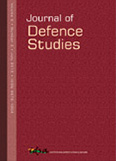Weaponisation of Space and India’s Options
During Cold War era, space became an essential adjunct for war-fighting on the ground, without becoming another theatre of combat. While militarization of space proceeded rapidly, the weaponisation of space was avoided. Because the weaponisation of space was avoided during the Cold War, it does not necessarily follow that weaponisation will continue to be avoided in a new era of asymmetric warfare. We can improve protection of satellites against some threats, but satellites will remain easy targets for space weapons designed to kill on impact. Space has been free from warfare.
- Deepak Sharma |
- July 2010 |
- Journal of Defence Studies





